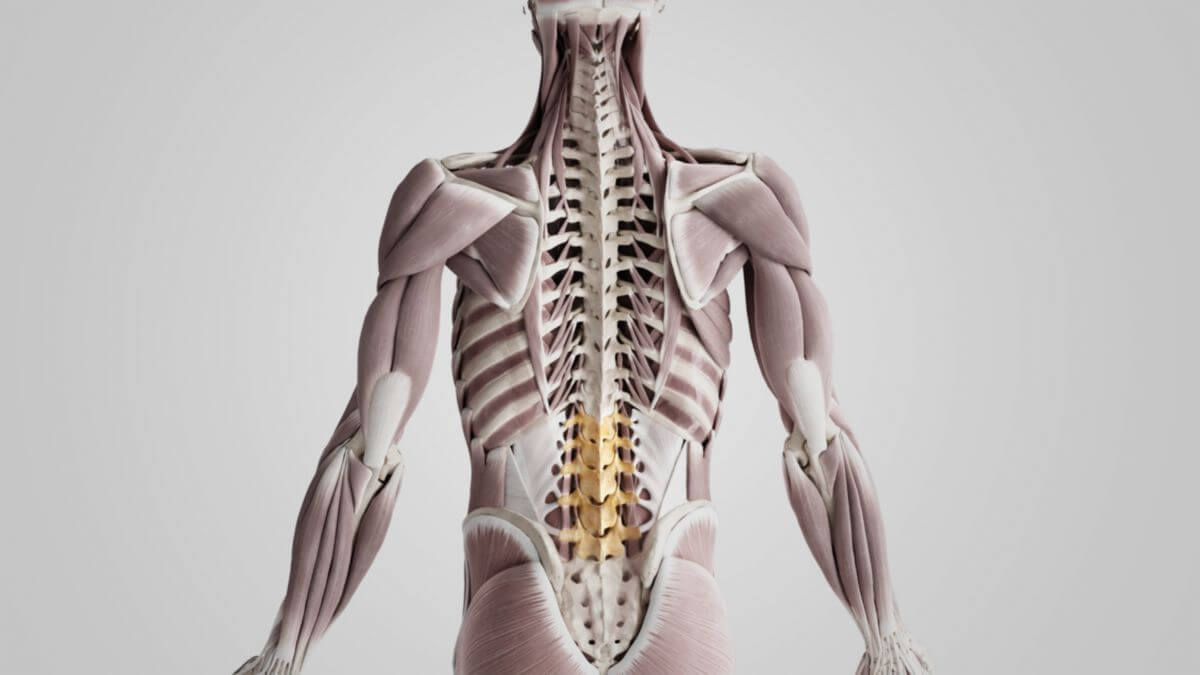Corpus: Lumbar spine: Unterschied zwischen den Versionen
(Englische Seite angelegt) |
K (Schützte „Corpus:Lumbar vertebra“ ([Bearbeiten=Nur Administratoren erlauben] (unbeschränkt) [Verschieben=Nur Administratoren erlauben] (unbeschränkt))) |
(kein Unterschied)
| |
Version vom 13. August 2024, 13:50 Uhr
This text has been translated by an AI and may sound raw. It will be reviewed shortly. Thank you for your patience!
This text has been translated by an AI and may sound raw. It will be reviewed shortly. Thank you for your patience!
Synonyms: lumbar spine, pars lumbalis columnae vertebralis, lumbar spine
Definition
The lumbar spine, or LWS for short, is a segment of the human spine that consists of five individual bones known as lumbar vertebrae (vertebrae lumbales). It is situated in the lower part of the spine, positioned between the thoracic spine and the sacrum (Os sacrum).
Overview
The lumbar vertebrae are numbered sequentially from cranial to caudal:
| Name | Acronyms | Latin |
|---|---|---|
| 1st lumbar vertebra | L1 | Vertebra lumbalis I |
| 2nd lumbar vertebra | L2 | Vertebra lumbalis II |
| 3rd lumbar vertebra | L3 | Vertebra lumbalis III |
| 4th lumbar vertebra | L4 | Vertebra lumbalis IV |
| 5th lumbar vertebra | L5 | Vertebra lumbalis V |
Anatomy
The five lumbar vertebrae are stacked vertically, forming a rod-like structure. In an upright posture, they create a concave curve directed dorsally, known as lumbar lordosis, which is a physiological curvature of the spine.
Each side of the spinal cord in the lumbar region gives rise to five spinal nerves, corresponding to segments L1 through L5. These nerves contribute to the lumbosacral plexus on both the right and left sides.
Basic shape
The vertebral bodies of the lumbar vertebrae share a common basic shape, characterized by their large size and bean-shaped outline compared to the vertebrae in other regions of the spine. The sagittal diameter of the lumbar vertebral body is smaller than its transverse diameter.
Key structural elements of the lumbar vertebrae include:
- the vertebral body (corpus vertebrae)
- the vertebral arch (arcus vertebrae)
From the vertebral arch, lateral and dorsal processes extend:
- Lateral processes: Transverse processes (processus transversi)
- Dorsal processes: Spinous processes (processus spinosi)
In the lumbar region, the spinous processes are covered laterally by the muscles of the back, and they can be palpated in the groove between the muscle bellies.
The vertebral foramen, enclosed by the vertebral body and arch, forms a space for the spinal cord (medulla spinalis) along with its sheaths, vessels, and nerves. From the level of the first or second lumbar vertebra onward, the spinal canal contains the cauda equina instead of the spinal cord.
The vertebral canal (canalis vertebralis) is formed by the alignment of individual vertebral foramina, while the intervertebral foramina between adjacent vertebrae allow for the passage of spinal nerves. The bony boundary of the intervertebral foramen is formed by the pedicles of the vertebral arch (pediculi arcus vertebrae), which are slightly indented cranially and caudally to form the superior and inferior vertebral notches (incisurae vertebrales inferiores et superiores).
Special features
Spinous Processes
In the lumbar spine, the spinous processes are oriented straight backward, leaving the spinal canal closed only by connective tissue, making it accessible for lumbar puncture.
Transvere processes
The transverse processes, also known as costal processes, are relatively long and can be considered rudimentary ribs. The true transverse processes (processus accessorii) lie dorsal to the costal processes and are less prominent.
Articular surfaces
The articular surfaces of the lumbar vertebrae are primarily oriented sagittally, except for the fifth lumbar vertebra, where the articular surface is nearly frontal. The mammillary processes (processus mamillares) are located on the posterior aspect of the superior articular processes.
Function
The primary function of the lumbar spine is to support and bear the weight of the trunk, providing stability to the upper body. This stability is reinforced by the surrounding back muscles.
Veterinary medicine
The number of lumbar vertebrae varies significantly across different animal species and can even differ within breeds of the same species:
- Carnivores: Typically 7 lumbar vertebrae
- Pigs: 5-7 lumbar vertebrae
- Sheep and goats: 6 lumbar vertebrae
- Cattle: 6 lumbar vertebrae
- Horses: 5-7 lumbar vertebrae

